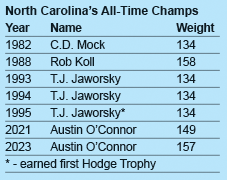Klessinger: O’Connor’s unwavering grit led to a second title

Photo: Austin O’Connor (left) fought off a challenge by Penn State’s Levi Haines at 157 pounds to capture his second NCAA championship, March 18, in Tulsa, Okla. This came after the Illinois native and 2021 champ at 149 pounds dealt with injuries that dropped him to eighth place at the 2022 NCAAs.
By John Klessinger
Substitute wrestling with any other life endeavor and it is the same. North Carolina’s Austin O’Connor demonstrated what we already know but quickly forget when adversity comes our way. Success is not a straight line. It is filled with pain and heartache. But that is why we love stories like O’Connor’s. Whatever happens in wrestling or life, get up, move forward, and keep believing in yourself.
O’Connor found out before the ACC tournament in 2022 that his ACL was partially torn. He knew full well that it would worsen if he wrestled. He was the returning 2021 NCAA champion. But, as I had come to learn about the Lockport, Ill., native, not wrestling wasn’t an option for him. Ingrained in O’Connor is an attitude of toughness and self-belief.
O’Connor would come into the 2022 NCAA tournament as the No. 11 seed; his lowest seed in the four years at the tournament. After placing sixth in 2019 and seed No. 2 in 2020, O’Connor came into 2021 as the two seed, upending No. 1 Sammy Sasso of Ohio State, 3-2, in the final.
The ACL injury prevented a repeat. In overtime, O’Connor lost his 2022 NCAA tournament opening match to Dazjon Casto from the Citadel. Through the progression of the ACC and NCAA tournaments, O’Connor would fully tear his ACL. After the loss to Casto, he won four consecutive consolation matches to earn his fourth All-American honor. He medically forfeited his remaining matches, placing eighth.
“I wanted surgery as soon as possible,” Austin recalled. “It hurt losing and placing eighth. But I knew I could win it again.”
His knee sustained a lot of trauma. Outside of reconstructing the ACL, his lateral collateral ligament (LCL) and medial collateral ligament (MCL) were damaged.
“I’ve always had the hard route,” he said. “I went into surgery confident. I knew it would be tough, but I also knew it would work out if I put in the time and sacrifice,” he said about his mindset before surgery.
Austin is no stranger to success. He was a four-time state champion at St. Rita of Cascia High School in Illinois. The middle of three children of Mike and Laura O’Connor, Austin had a phenomenal 181-4 record in high school. Each of his four losses was by one point, and he went undefeated in his junior and senior seasons. His older brother Michael was a three-year Division III letter winner at Central College in Iowa. The youngest O’Connor, Austin’s sister Chloe, is a high school soccer player.
Recovery from ACL reconstruction surgery takes at least six months, or even up to a year or longer. I know it is arduous from experience with two children going through it. My son, Mason, is five months post-surgery and is on track to get cleared in nine months. On the other hand, my daughter, Ellie, needed a second surgery in 2020 and her clearance was delayed well past a year. It’s a physical and mental challenge filled with highs and lows.
“My goal was to have the quickest ACL recovery ever,” O’Connor said.
Following a few weeks of pain and being stuck on the couch, O’Connor started physical therapy with the North Carolina training staff.
“I was going twice a day every day,” he said.
Regardless of what he did, he couldn’t get the flexion the trainers wanted. After three months, O’Connor had a second surgery to remove scar tissue that built up after the surgery and was given two manipulation devices to help with bending and straightening his leg.
“Torture devices,” he described. 
O’Connor wore one of them at night that bent and straightened his leg while sleeping. Or, at least, he tried to sleep.
“It was tough to get comfortable,” O’Connor laughed when I asked him if sleeping was difficult.
“Rehab took its toll. I am stubborn but realized I can’t grind through an injury. The second surgery hit me, and I doubted whether or not this would heal.”
O’Connor reminded himself to not get down and stay confident. Eventually, O’Connor was hand-fighting without movement. By six months, he began drilling. Things were progressing, and around November, he started live wrestling.
In Tulsa, O’Connor won his second NCAA title with a 6-2 decision over Penn State’s Levi Haines. The Tar Heel looked like he did in 2021; physical and tough to score on.
“Yeah, I was a little shaky at first when I first returned to the mat, but by the end of the season, I was 100 percent,” said O’Connor.
For someone who hasn’t seen firsthand the struggles of an athlete returning from injury, O’Connor should have an asterisk by his second championship. So many don’t come back and do things that he did. First, wrestling through the injury and being an All-American in 2022 is something few do in wrestling when healthy. But then, to go through nine months of intensive rehab and win arguably the toughest tournament in NCAA sports is remarkable.
O’Connor has lived the sport of wrestling. In his words, it’s a “lifestyle. Don’t shy away from hard things. Welcome challenges. You can’t be afraid.”
He knows if it weren’t for wrestling, he wouldn’t be at one of the best colleges in the United States.
“The sport has given back to me what I put into it. It’s been life-changing,” said O’Connor, who learned early from his mentors that being a student-athlete has three aspects: athletics, academics, and social life. But, he said, to be successful, you can only give a lot of time to two.
“You have to align your goals with those aspects. I have had to sacrifice and cut out some social aspects to get where I wanted to be. I always wanted to be that guy,” said O’Connor.
From a fan perspective, O’Connor’s career has been quietly great. He doesn’t get the limelight like the ones from the Big Ten. Talking with him, he was humble. Matter of fact. Compound that with the determination of a pit bull, and you have the perfect model for others to follow. What he did in his career can no doubt be considered extraordinary. But what we can learn from him is invaluable. With or without an injury, we can model his toughness and grit. We can model his trust in his training and recovery. He had doubts but pushed them aside and remained steadfast in his commitment to returning to his 2021 level.
O’Connor’s story is a story that I will tell my son. It is another bend in a winding road called life. In the bend, you often discover something inside yourself you didn’t know existed. A recognition that you are stronger than you think. And from that strength, hidden underneath the pain and discomfort, is the recipe for greatness.
(John Klessinger is a teacher and wrestling coach at South River High School in Maryland. You can follow him on Instagram @coachkless and like his Facebook page “Coach Kless”.)











